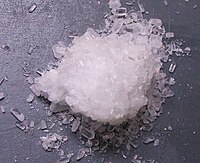
Photo from wikipedia
Background and Objectives: Shivering is a common complication of subarachnoid block (SAB). Magnesium sulphate has been proven to be effective in preventing shivering. The aim of this study was to… Click to show full abstract
Background and Objectives: Shivering is a common complication of subarachnoid block (SAB). Magnesium sulphate has been proven to be effective in preventing shivering. The aim of this study was to compare the effectiveness and adverse effects in hemodynamic parameters between 50 mg/kg and 30 mg/kg of intravenous magnesium sulphate for prevention of shivering post-subarachnoid block. Materials and Methods: Eighty-six patients scheduled for surgery under SAB, aged between 18 to 65 years old with American Society of Anesthesiologists physical status I and II were randomised into two groups. Group A received a bolus of 50 mg/kg, while Group B received 30 mg/kg of intravenous magnesium sulphate, given over a 20 min duration following SAB. Shivering grade was recorded intraoperatively according to the Crossley and Mahajan shivering scale. Mean arterial pressure (MAP), heart rate, tympanic temperature, oxygen saturation and the use of vasopressors were recorded. Results: Forty-five percent of patients in Group A and 20% of patients in Group B did not exhibit shivering (p-value < 0.01). High-grade shivering was observed in 12.5% in Group A and 40% in Group B, respectively (p-value 0.02). The MAP trend was lower in Group B (p-value < 0.01), but the incidence of hypotension was not significant in both groups. The use of vasopressors was also similar between groups. Group B showed a lower oxygen saturation trend (p-value 0.04). The trends of heart rate and tympanic temperature were not significant in both groups. No patients had episodes of bradycardia or oxygen desaturation. Conclusions: In this study, intravenous magnesium sulphate 50 mg/kg is the lowest effective dose for prevention and treatment of high-grade shivering post-SAB without significant hemodynamic adverse events.
Journal Title: Medicina
Year Published: 2022
Link to full text (if available)
Share on Social Media: Sign Up to like & get
recommendations!